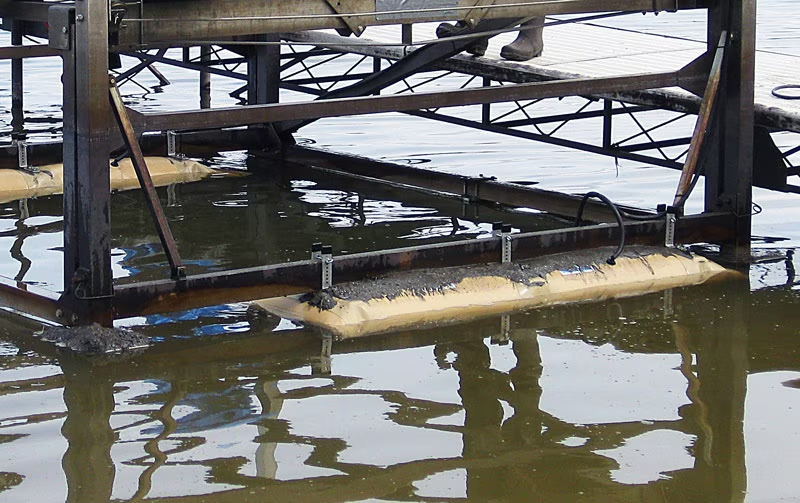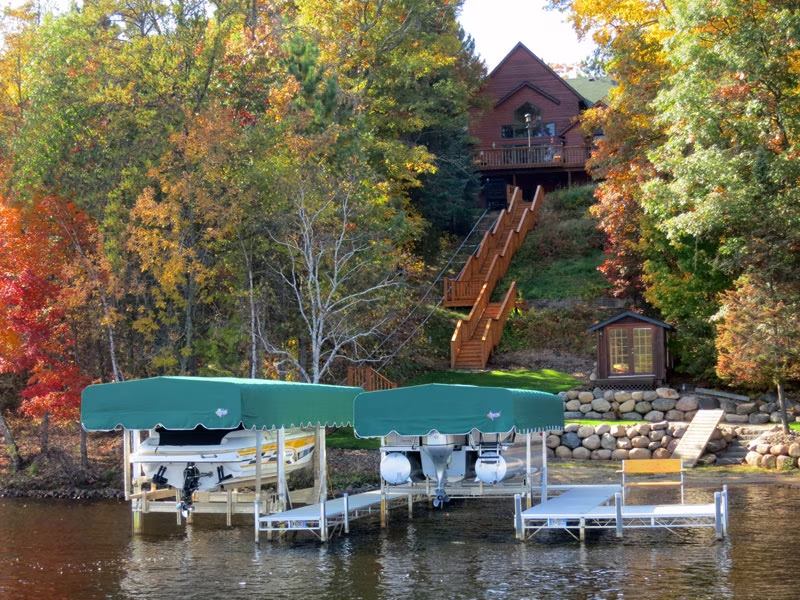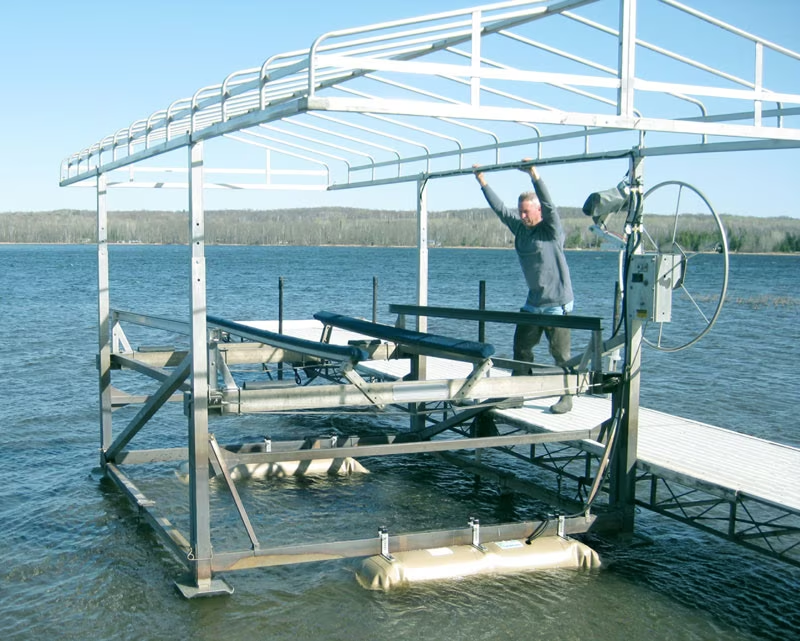No heavy lifting required!
By Mark Boncher

Kersplooosh!
That is the sound my boat made when the old boat lift cable finally snapped. All 2,800 pounds of ski boat dropped 2 feet into the water in an instant. Not my proudest or happiest moment. I blame this unfortunate incident on my water-loving family’s lifelong quest to never pay too much (for anything). We have had thriftiness implanted into our brains, and therefore I’ve never bought a new boat lift, even though I’ve owned numerous boat lifts throughout the past 30 years. Unfortunately, at least one I bought and began using without doing the proper maintenance checks first. Hence, my dad-ism of the day, “Do as I say, not as I do.” In this article, I’ll address the three main types of inland water freestanding boat lifts: vertical, cantilever and floating. The majority of lifts today are vertical (straight up and down), unless you live on shallower waters where a cantilever lift is more suited.
Just follow the cable
Most of the major maintenance on lifts revolves around the cable and winch system. Floating lifts require a little less maintenance than the other types and tend to be used primarily for watercraft and smaller boats. They have become more popular in recent years. Any rollers, winches and cables, and other moving parts should be checked, lubricated if needed, or replaced over time. Also, check for leaks in the floats, and clean and rinse all plastic and metal areas. Cantilever lifts go up and down on an angle and can often put more stress on the cable. The aforementioned lift accident involved a cantilever lift. Cables, especially on cantilever lifts, should be replaced every 3 years or so. Check the cable for burrs annually, and make sure it is not “rounded out,” or more importantly, make sure it is not frayed. Check any areas that the cable is anchored to, and make sure the cable is still anchored securely with good clamps and thimbles. (This is especially important on cantilever lifts, as the cable is anchored on one side and always exposed.)

If you are replacing your cable, or the cable was replaced in the past, make sure it is the correct size and rated correctly for your lift. There is usually a small OEM plate near the winch that can help you determine weight ratings and therefore the correct cable grade, length or size if you do not know. In addition, make sure that all pulleys, rollers, bearings or bushings are moving freely. Make sure all nuts, bolts and clamps are tight with a wrench. There should be no debris: bird nests, wasp nests, squirrel nests, or anything else in or around the winch and its housing. You will want to grease any areas that need it. You can also spray the cable periodically with corrosion preventative lubricant. Refer to the gear plate assembly for lubrication points, grease these with heavy-duty marine grease at least every year, if not more often. When greasing the hub, lower the platform until it rests on the lower frame so that there is no tension on the cable. Most lifts have an acorn nut and flat washer on the lift wheel-drive shaft; you can turn the wheel counterclockwise and remove it. Place a light application of grease on the coarse threads.
How are the feet?
Check that all the feet on the lift are still firmly held in place so that they do not come off when moving the lift, or once it is in the water.
Don’t forget the bunk
Bunk maintenance is also important. Inspect the carpeting for wear/tear and see that the bolts holding the bunks are tight and that the bunks continue to line up correctly with the hull of your boat. Inspect the condition of the wood under the carpet if you have wooden bunks. Replace carpet or wood if necessary.
Off-Season Care for Your Lift & Cover
How did your boat lift weather the winter? If you live in the Frostbelt and your lift didn’t winter well, you may want to dog-ear this page so you can try these tips this autumn.
Storing Your Lift
If you remove your lift from the water each fall, here are some tips: Store your lift with the cradle or platform all the way up. This is especially important if you have a hydraulic hoist (winch system) so the hydraulic ram on the cylinder is not exposed during the off-season. Take the battery out if you have a power hoist and store it inside on a small piece of wood. (If you have an older-style motor that you have to hold against the wheel on the lift, remove it and store the motor inside as well.) Make sure you stay safe when servicing your lift. Do not stand on or lay under the cradle of the lift. Also, do not use makeshift cables, clamps, or other devices to hold the wheel, the cradle, or any other moving pieces in place.

TLC for Your Cover
If you have a canopy with a cover over your lift, remove the cover, wash it with soap and water, let it thoroughly dry, then store it in a dry place. Take off all the bungee cords, springs, or whatever else holds your canopy cover on, and store those pieces along with it. Note: It is often easier to remove the cover while the boat is in the lift. You can stand and move around in the boat, making it easier to reach the bungees or springs that hold the cover, and easier to roll up the cover from one end to the other.
Stop Being Cranky About Cranking
If you have kids around or a helpful cabin guest, chances are you can get them to do the dreaded chore of cranking your boat up out of the water. But for many, spending a little dough on an electric motor to raise your lift is well worth the investment. There are numerous manufacturers, but Shoreline Industries (www.shoreline-ind.com) has a new quiet, powerful and efficient system called the Sidewinder. The direct-drive boat lift motor attaches right to your lift’s existing winch and it fits most major brands. The unit works for lifts rated up to 7,000 pounds.
Move Your Boat Life Easily
Repositioning or moving your lift is not a one-person job. A new product called The Boat Lift Helper (www.boatlifthelper.com) is designed to make this chore much easier. Basically, it is a system using heavy-duty, military-strength air-lift bags to raise your boat lift up off the lake bottom. The bags allow you to float your lift to the desired spot when putting it in, when repositioning it, or to shore it if you are taking it out for the winter. The air bags easily attach to the frame of any lift and can be quickly inflated with nearly any kind of pump or small compressor. The standard air bags work on up to an 800-pound lift. Bags are available for heavier lifts.
 If you are replacing your cable, or the cable was replaced in the past, make sure it is the correct size and rated correctly for your lift. There is usually a small OEM plate near the winch that can help you determine weight ratings and therefore the correct cable grade, length or size if you do not know. In addition, make sure that all pulleys, rollers, bearings or bushings are moving freely. Make sure all nuts, bolts and clamps are tight with a wrench. There should be no debris: bird nests, wasp nests, squirrel nests, or anything else in or around the winch and its housing. You will want to grease any areas that need it. You can also spray the cable periodically with corrosion preventative lubricant. Refer to the gear plate assembly for lubrication points, grease these with heavy-duty marine grease at least every year, if not more often. When greasing the hub, lower the platform until it rests on the lower frame so that there is no tension on the cable. Most lifts have an acorn nut and flat washer on the lift wheel-drive shaft; you can turn the wheel counterclockwise and remove it. Place a light application of grease on the coarse threads.
If you are replacing your cable, or the cable was replaced in the past, make sure it is the correct size and rated correctly for your lift. There is usually a small OEM plate near the winch that can help you determine weight ratings and therefore the correct cable grade, length or size if you do not know. In addition, make sure that all pulleys, rollers, bearings or bushings are moving freely. Make sure all nuts, bolts and clamps are tight with a wrench. There should be no debris: bird nests, wasp nests, squirrel nests, or anything else in or around the winch and its housing. You will want to grease any areas that need it. You can also spray the cable periodically with corrosion preventative lubricant. Refer to the gear plate assembly for lubrication points, grease these with heavy-duty marine grease at least every year, if not more often. When greasing the hub, lower the platform until it rests on the lower frame so that there is no tension on the cable. Most lifts have an acorn nut and flat washer on the lift wheel-drive shaft; you can turn the wheel counterclockwise and remove it. Place a light application of grease on the coarse threads.















